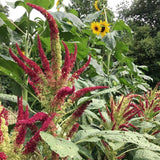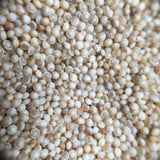Golden Red Amaranth
Amaranthus spp.
Golden Amaranth was gathered in 1978 in a door-yard garden near Rinconada, New Mexico by Native Seeds/SEARCH and I received seed from Miguel Santisteven when I was visiting him and his family in Taos a few years back. We wanted to see how it would adapt to Philly. It is gorgeous, and has spinach-like young greens as well as protein-packed golden seeds, which are great as porridge and incorporated into tortillas. It turns out his variety had some crossing with Hopi Red and/or Elephant Head amaranths giving the flowers maroon tips. Miguel says: "I like promiscuity in plants, I believe that gives Nature a chance to express herself as she wants." Rowen White of the Indigenous Seed Keepers Network adds that "Landraces that are full of different expressions is where our resilience is at". Grow this variable beauty in your garden and allow it to adapt to your soil and climate. In addition to great culinary uses, amaranth is a great distraction for cucumber beetles - they prefer it. I plant it throughout my squash and cucumber patches, and in turn, it also makes a beautiful backdrop to the seed garden.
Days to maturity: 100-110
Seeds per pack: 400
Germination rate: 93% on 05/16/2025
Planting / harvesting notes
Amaranth is an extremely self-sufficient crop. Expect germination between 10-20 days, and fast growth after that. At this point on our farm, amaranth has seeded itself enough that we harvest many young, tender plants whole at 12" as a way of thinning, but the plants we allow to mature are given about 2' space in each direction. Mature plants have deep pink taproots that allow them to go long periods of time without watering, and shoot up thick, bushy branches.
Seed keeping notes
Amaranth is wind pollinated. Isolate by a minimum of 500 feet or cover the flowers with corn tassel bags to prevent unwanted cross pollination with other amaranths. Seeds are ready when they start dropping from the seed head, which matures after the flower dies back. You can cut the whole seed head and hang it to dry and mature further in a dry, ventilated place, or you can shake it while still on the plant every day or two, as the seeds ripen at different times starting from the bottom to the tip. Either way, shake the plant in a bucket to release the seeds. Use a strainer to sift out the larger chaff. Use your breath, wind, or fans to winnow off lighter weight chaff.







